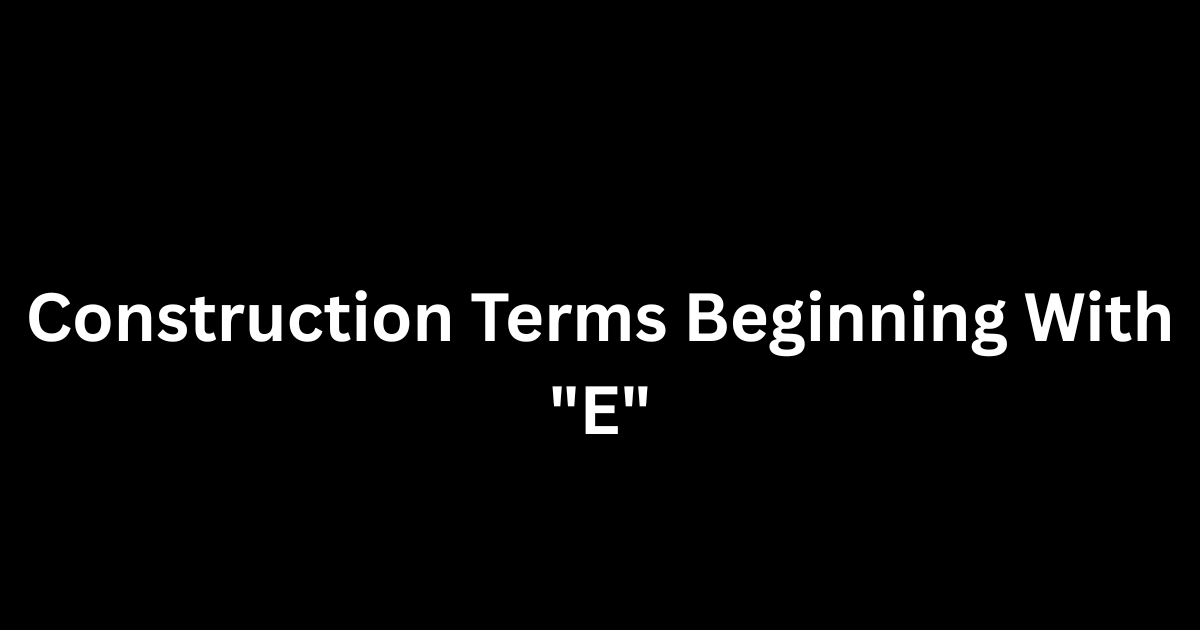Introduction
Construction language is precise for good reason – a single misunderstood term can cause safety hazards, budget overruns, or structural failures.
This comprehensive reference covers 15 essential “E” terms every construction professional needs, organized into practical categories. Each term includes:
- A clear, no-nonsense definition
- Why it matters on real job sites
- Case studies with verifiable data
- Common pitfalls to avoid
Bookmark this guide whether you’re a contractor reviewing specs, an engineer designing systems, or an apprentice learning the trade.

Structural & Civil Engineering Terms
1. Efflorescence
Definition: White salt deposits on masonry caused by water evaporation.
Why it matters: The Denver Justice Center faced $420,000 in facade repairs from unchecked efflorescence degrading brickwork.
Solution: Proper weep holes and vapor barriers reduce occurrences by 75% (NCMA study).
2. Egress
Definition: Exits and escape paths in buildings.
Tragic case: The Station Nightclub Fire (2003) killed 100 people due to inadequate egress. This led to stricter IBC codes.
Key requirements:
- Minimum 32″ clear width
- Maximum 20′ dead-end corridors
- Illuminated exit signs
3. Embankment
Definition: Compacted soil structure for roads/railways.
Engineering feat: China’s Jiaozhou Bay Bridge used 45 million cubic meters of embankment material – enough to fill 18,000 Olympic pools.
Electrical & Mechanical Systems
4. EMT (Electrical Metallic Tubing)
Definition: Thin-wall steel conduit for wiring.
Cost fact: Using EMT instead of rigid conduit saves $1.75 per linear foot (2023 RSMeans data).
Installation tip: Support every 10′ and within 3′ of boxes (NEC Article 358).
5. Expansion Tank
Definition: Hydronic system component absorbing water pressure increases.
Failure example: A Boston high-rise lost heat when an undersized tank ruptured, costing $180,000 in emergency repairs.
Sizing rule: 6% of total system volume.
Materials & Equipment
6. Epoxy Grout
Definition: High-strength, chemical-resistant filler.
Industrial case: Chevron’s Richmond refinery uses epoxy grout that withstands 12,000 psi and 400°F temperatures.
Cure time: 24-72 hours (vs 7-28 days for cement grout).
7. Excavator
Types:
- Mini (under 6 tons)
- Standard (20-50 tons)
- Long-reach (for dredging)
Productivity stat: A Cat 336 excavator moves 175-220 cubic yards per hour in typical conditions.
Project Management Terms
8. Earned Value Management (EVM)
Definition: Method tracking project performance.
NASA success: Used EVM to complete the James Webb Telescope within 1.2% of its $10 billion budget.
Key metrics:
- CPI (Cost Performance Index)
- SPI (Schedule Performance Index)
9. Extra Work Order
Definition: Contract amendment for unplanned work.
Dispute data: 38% of construction lawsuits involve poorly documented change orders (ABA report).
Best practice: Require signed EWO before work begins.
Building Envelope & Finishes
10. EIFS (Exterior Insulation Finish System)
Definition: Synthetic stucco cladding.
Moisture warning: Improperly installed EIFS caused widespread rot in 1990s coastal homes, leading to class action suits.
Modern solutions: Drainage mats and proper flashing now required.
11. Edge Protection
Definition: Fall prevention for roofers.
OSHA fact: 38% of construction deaths are falls. Proper edge guards reduce risk by 67%.
Types:
- Guardrail systems
- Safety nets
- Personal fall arrest
Environmental & Safety Terms
12. Erosion Control
Definition: Preventing soil loss on sites.
Regulation: NPDES permits require controls for sites over 1 acre.
Effective methods:
- Silt fences (reduces sediment runoff by 60%)
- Hydroseeding
- Check dams
13. Eye Wash Station
Definition: Emergency equipment for chemical exposure.
OSHA standard: Must be within 10 seconds’ reach where corrosive materials are used.
Maintenance tip: Weekly activation tests prevent sediment buildup.
Emerging Technology Terms
14. Energy Modeling
Definition: Software predicting building performance.
Case study: The Bullitt Center (Seattle) used modeling to achieve 83% energy reduction versus typical offices.
15. Electric Construction Equipment
Market shift: Volvo reports 35% of European sites now use electric excavators.
Benefits:
- 70% lower operating costs
- Zero emissions
- 50% less noise
Common “E” Term Mistakes
- Ignoring efflorescence – leads to costly masonry repairs
- Inadequate egress – creates life safety risks
- Skipping expansion tanks – causes plumbing system failures
- Poor erosion control – results in EPA fines up to $56,460 per violation
- Miscalculating earned value – hides project overruns until too late

